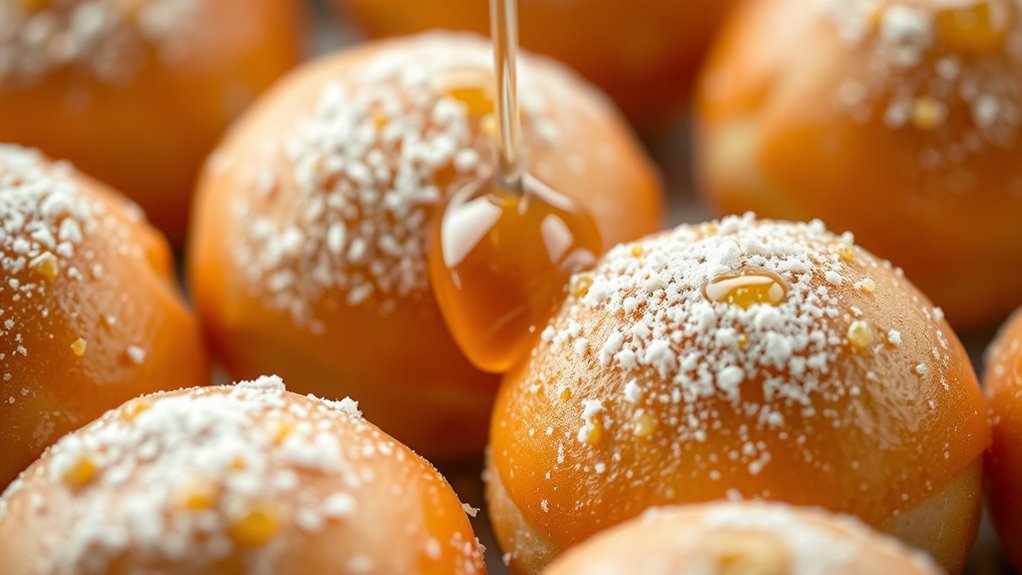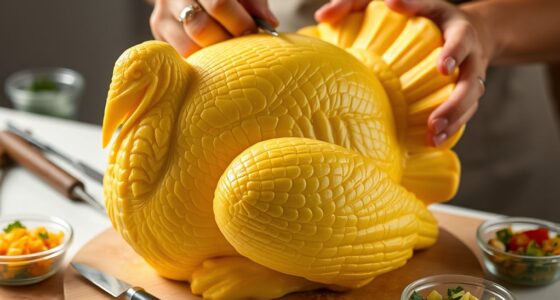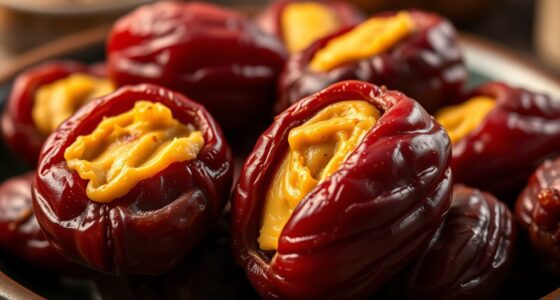To prevent grease absorption in your Hanukkah brown-butter sufganiyot, choose oils with high smoke points like vegetable or canola and maintain a steady frying temperature of around 350°F. Properly prepare your brown butter for rich flavor, ensure your dough is soft and rested, and avoid overfilling or overworking it. After frying, drain your sufganiyot on wire racks and let them cool completely. Keep everything light, tender, and well-drained to enjoy perfect sufganiyot each time—you’ll discover more tips as you continue.
Key Takeaways
- Use high smoke point oils like vegetable or canola to prevent burning and reduce grease absorption.
- Maintain a consistent frying temperature (~350°F/175°C) to avoid over-absorption and sogginess.
- Drain sufganiyot immediately on wire racks or paper towels to remove excess oil.
- Properly prepare and cool brown butter to enhance flavor and minimize greasiness.
- Serve at room temperature and store in a single layer to preserve texture and prevent grease buildup.
Choosing the Right Oil for Frying
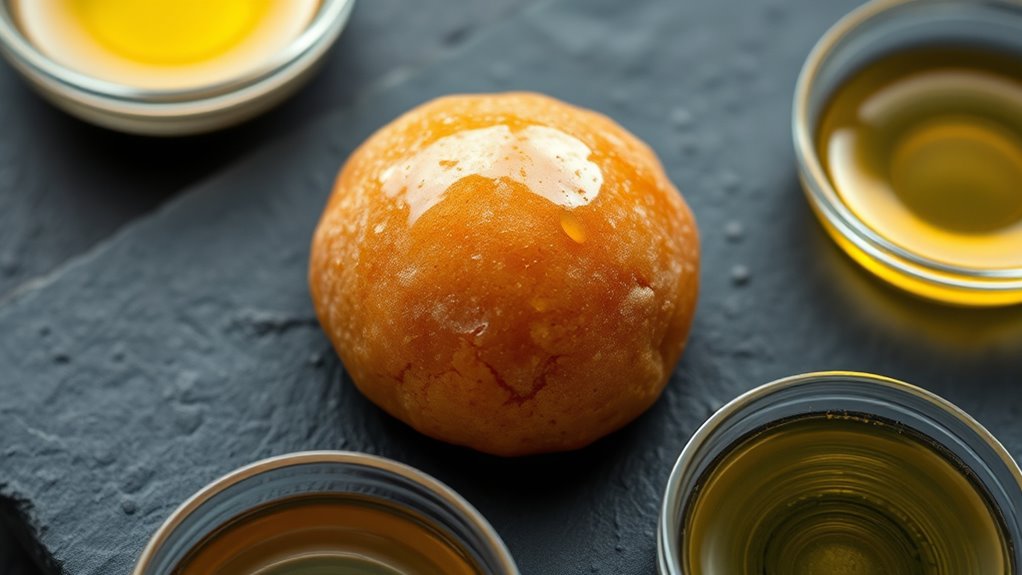
When choosing oil for frying, it’s vital to pick one with a high smoke point to make sure your sufganiyot turn out perfectly crispy without burning. Different types of frying oils have varying smoke points, so selecting the right one matters. For example, vegetable oil, canola oil, and sunflower oil all have high smoke points, making them ideal for deep-frying. On the other hand, oils like extra virgin olive oil have lower smoke points and can burn at high temperatures, affecting flavor and texture. Always consider smoke point considerations when selecting your oil, as overheating can lead to undesirable flavors and greasy results. Using an oil suited for high heat ensures your sufganiyot are evenly cooked, crispy, and delicious without absorbing excess grease.
Preparing Brown Butter for Optimal Flavor and Texture
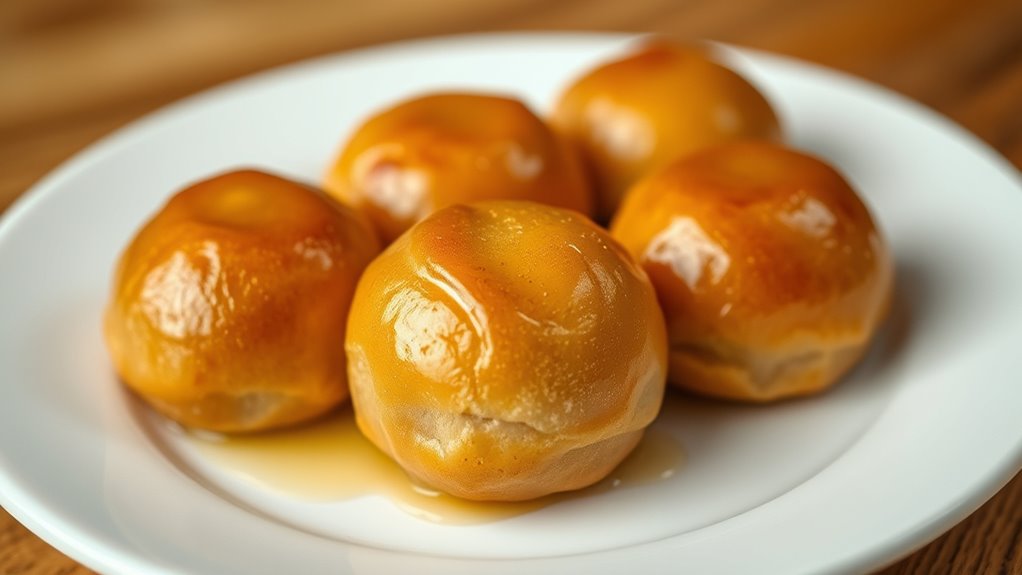
To develop rich, complex flavor in your sufganiyot, start by preparing brown butter carefully. Melt butter over medium heat, watching closely as it begins to foam and release a fragrant butter aroma. Stir constantly to guarantee even browning and prevent burning. As the butter turns a deep amber, it develops caramel notes that add depth to your dough. Remove the pan promptly to stop the cooking process and preserve the perfect flavor. Let the brown butter cool slightly before incorporating it into your dough. This step enhances the sufganiyot’s taste and texture, giving them a nutty, rich flavor profile. Paying attention to the browning process guarantees you access the full potential of the butter’s aroma and caramel notes, elevating your Hanukkah treats. Necessary cookies can help ensure the optimal functioning of your baking process and prevent issues during preparation.
Proper Temperature Control During Frying
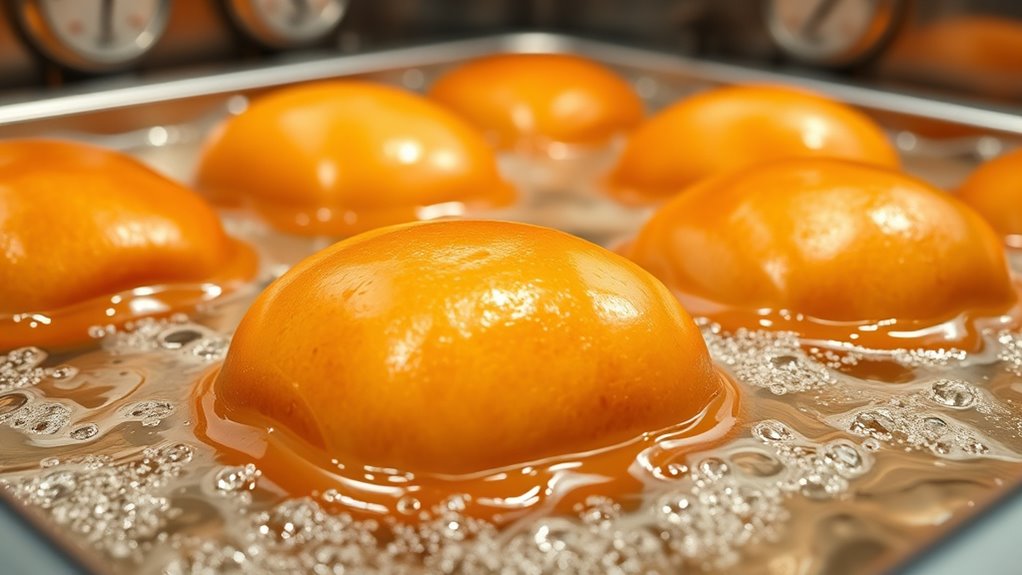
To get perfect sufganiyot, you need to keep the oil at a consistent temperature. Using a thermometer helps you stay precise and avoid burning or undercooking the dough. Maintaining control guarantees your treats turn out golden and tender every time. Consistent temperature control is essential for achieving optimal frying results and preventing excess grease absorption.
Maintain Consistent Oil Temperature
Maintaining a consistent oil temperature is essential for achieving perfectly fried sufganiyot. Fluctuations in oil temperature can lead to uneven frying, causing the outside to burn or the inside to remain undercooked. To ensure frying consistency, monitor the oil closely throughout the process. When the oil is too hot, the sufganiyot may brown quickly but absorb excess grease; if it’s too cool, they’ll soak up more oil and turn out greasy. Keep the temperature steady by adjusting your heat as needed and avoid overcrowding the pan, which can cause drops in temperature. Consistent oil temperature helps your sufganiyot develop a light, golden crust while preventing grease absorption, resulting in a perfect, fluffy texture.
Use a Thermometer for Accuracy
Using a thermometer is essential for precise temperature control during frying, ensuring your sufganiyot come out perfectly. Accurate thermometer accuracy helps you monitor oil temperature consistently, preventing overheating or undercooking. Proper temperature monitoring allows you to maintain the ideal frying temperature, typically around 350°F (175°C), which is key to achieving light, fluffy dough and avoiding grease absorption. Without a reliable thermometer, you risk uneven cooking, soggy texture, or greasy results. Keep your thermometer probe submerged in the oil, avoiding contact with the pan’s sides or bottom for accurate readings. Regularly check the temperature throughout frying, making adjustments as needed. This focus on temperature accuracy ensures your sufganiyot are golden, tender, and free from excess grease. Monitoring digital payment solutions can help you manage your cooking process more efficiently by providing precise control and real-time data.
Ensuring Proper Dough Consistency for Lightness

Achieving the perfect dough consistency is key to making light, airy sufganiyot. To do this, focus on dough elasticity, which ensures the dough can stretch without tearing. Use proper mixing techniques, combining ingredients just enough to develop gluten without overworking the dough. Overmixing can lead to dense results, while undermixing may cause uneven texture. Monitor the dough’s feel; it should be soft, slightly tacky, and springy. Here’s a quick guide:
| Tip | Result |
|---|---|
| Mix until just combined | Prevents overdeveloping gluten |
| Use a gentle fold method | Keeps dough airy and light |
| Rest dough adequately | Improves elasticity and flavor |
| Avoid overmixing | Ensures tender, fluffy sufganiyot |
| Check dough texture | Achieves the desired lightness |
| Proper resting time helps develop dough elasticity, which is essential for a light and airy final product.
Techniques for Shaping and Filling Sufganiyot
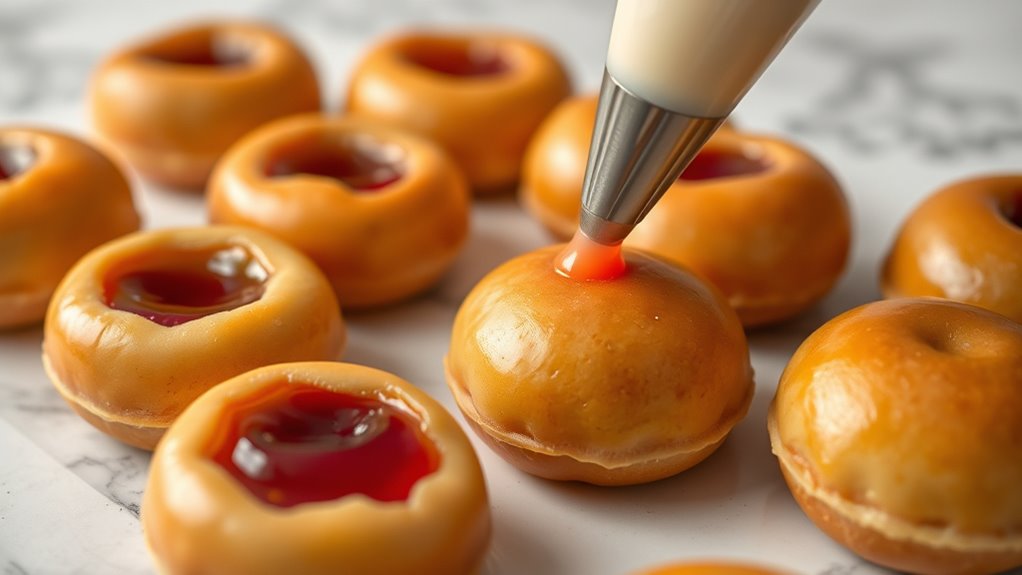
Once you’ve prepared your dough, shaping and filling sufganiyot requires careful handling to guarantee they turn out perfectly. Proper dough shaping ensures a uniform size and prevents oil absorption. When filling, use the right technique to avoid mess and overstuffing. Here are some key ideas:
Careful shaping and filling ensure perfect, fluffy sufganiyot with minimal grease.
- Roll the dough evenly to prevent uneven browning.
- Use a round cutter to shape the sufganiyot consistently.
- Fill a piping bag with jam or custard, inserting it gently into the side or center of each dough circle.
- Avoid overfilling to prevent bursting during frying.
- Ensuring the dough is properly proofed can help maintain the right texture and minimize grease absorption. Proper proofing techniques help achieve the ideal consistency for frying.
Mastering dough shaping and filling techniques helps create light, fluffy sufganiyot with minimal grease absorption. Precision in these steps contributes to a professional presentation and delicious texture.
Draining and Cooling to Minimize Grease Absorption
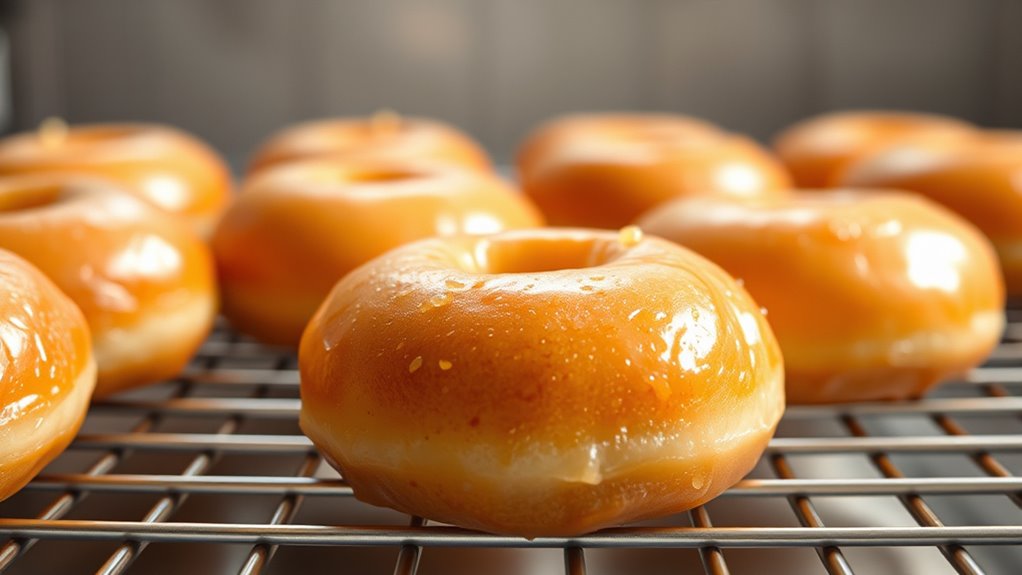
After frying your sufganiyot to golden perfection, it’s essential to drain them thoroughly to prevent excess grease from soaking in. Use proper draining techniques by placing the fried donuts on a wire rack or paper towels immediately after removal from the oil. This allows excess oil to drip away quickly, reducing grease absorption. Once drained, employ effective cooling methods by letting the sufganiyot sit at room temperature for a few minutes. This step helps stabilize the structure and prevents moisture buildup, which can lead to sogginess. Avoid stacking hot sufganiyot directly on each other, as trapped heat and steam can increase grease retention. Proper draining and cooling are vital to achieving light, airy sufganiyot with minimal greasiness. Incorporating energy-efficient kitchen appliances can further streamline your frying process, making it safer and more environmentally friendly.
Tips for Serving and Storing Your Sufganiyot

To keep your sufganiyot fresh and delicious, use proper storage techniques like airtight containers at room temperature or in the fridge. When serving, consider warming them slightly for the best flavor and texture. Following these tips guarantees your treats stay tasty and enjoyable for everyone. Additionally, avoiding excess grease absorption can be achieved by proper frying techniques, ensuring your sufganiyot remain light and fluffy.
Proper Storage Techniques
Proper storage begins with allowing your sufganiyot to cool completely before packaging them. This prevents condensation, which can make them soggy. Use air tight containers to keep moisture out and maintain freshness. When refrigerating, employ proper refrigeration techniques: store in a single layer to prevent crushing and avoid stacking. If you plan to keep them longer, consider placing a paper towel in the container to absorb excess grease. Keep the container in a cool, dry place or in the fridge if you need to extend their shelf life. Always label and date the container to track freshness. Additionally, understanding precious metals investment can inform broader strategies for financial security. By following these tips, your sufganiyot stay delicious and maintain their texture, ready for your next celebration.
Best Serving Practices
For the best experience, serve your sufganiyot at room temperature to enjoy their full flavor and soft texture. Present them on an attractive plate or platter to enhance their visual appeal and make them inviting. Consider a simple, elegant presentation that highlights their golden-brown exterior and dusting of powdered sugar. When serving, think about flavor pairing—pair your sufganiyot with complementary accompaniments like fresh fruit, a drizzle of chocolate, or a side of vanilla yogurt to elevate the tasting experience. Avoid overcrowding the plate to keep each piece distinct and appealing. Proper serving and presentation not only enhance the visual appeal but also guarantee that every bite remains tender and flavorful, making your Hanukkah celebration even more memorable. Incorporating presentation techniques can further elevate the overall experience.
Frequently Asked Questions
How Can I Tell if My Oil Is Hot Enough Without a Thermometer?
To tell if your oil is hot enough without a thermometer, you can use simple frying techniques. Drop a small piece of dough or bread into the oil; if it sizzles and rises to the surface quickly, your oil temperature is good. You want it around 350-375°F for frying. This method helps verify even cooking and prevents greasy sufganiyot, making your frying process more successful.
What Are Common Mistakes That Cause Greasiness in Sufganiyot?
Greasy sufganiyot feel like soaked sponges, dulling the joy of frying. Common mistakes include overmixing the dough, which develops excess gluten and traps oil, or improper cooling, causing oil to seep in as they cool too quickly. You might also fry at too high a temperature, creating a crust that traps grease inside. To avoid this, mix just until combined and let the donuts cool completely on a wire rack before filling.
Can I Reuse Fry Oil Without Affecting the Sufganiyot’s Quality?
You can reuse fry oil, but keep in mind that oil quality declines each time you do. Reusing oil may affect flavor retention and cause off-flavors, which could impact the taste of your sufganiyot. To maintain the best quality, strain the oil thoroughly and avoid reusing it too many times. This way, you preserve the oil’s integrity, ensuring your sufganiyot stay delicious without becoming greasy or flavorless.
How Long Should Sufganiyot Be Fried for Perfect Texture?
To achieve perfect texture, you should focus on frying duration and maintaining the right oil temperature. Fry your sufganiyot for about 2-3 minutes per side, ensuring the oil stays at 350°F (175°C). This balance prevents undercooking or greasiness. Keep a thermometer handy, and flip the donuts once they turn golden brown. Consistent frying time and proper temperature help you get soft, fluffy, and perfectly cooked sufganiyot every time.
What Are Alternative Toppings to Reduce Greasiness?
While choosing toppings, you might think sweetness is everything, but opting for alternative toppings can cut greasiness. Dusting options like powdered sugar or cocoa powder add flavor without excess oil. Fresh fruit or a drizzle of honey can elevate the sufganiyot while keeping them lighter. These toppings provide a balanced contrast, preventing the pastry from becoming overly greasy, and guarantee each bite stays deliciously satisfying.
Conclusion
By following these tips, you’ll enjoy perfectly crispy, light sufganiyot every time. For example, imagine serving golden brown sufganiyot at your Hanukkah gathering, with minimal grease and maximum flavor. When you choose the right oil, control the temperature, and drain properly, you create treats everyone will love. So, get creative with your fillings and enjoy the festive season with delicious, less greasy sufganiyot that impress and delight your family and friends.
